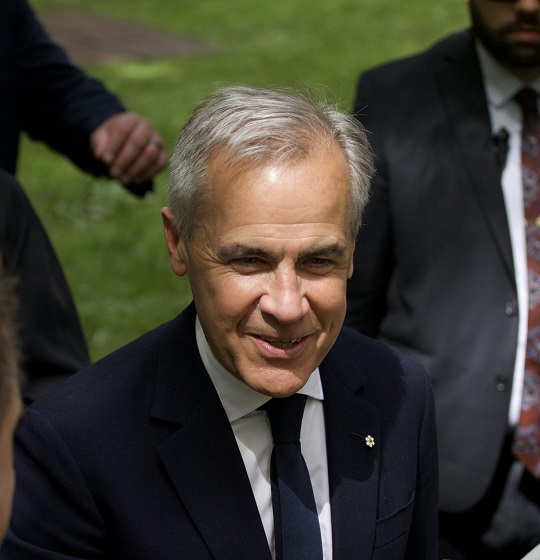Economy
Ruling-Class Energy Ignorance is a Global Wrecking Ball

From the Frontier Centre for Public Policy
By Terry Etam
In the US resides a guy who’s academic and professional credentials are as impressive and impeccable as one can assemble in a career. His Wikipedia professional/academic bio shows top-level roles at a who’s who of globally significant institutions.
Larry Summers has been: student at MIT, PhD from Harvard, US Secretary of the Treasury, director of the National Economic Council, president of Harvard University, Chief Economist of the World Bank, US federal Under Secretary for International Affairs in the Department of Treasury, a managing partner at a hedge fund, and is now on the board of OpenAI.
And yet…just a few weeks ago, Larry Summers made a comment about a bedrock of the economy seems so fundamentally bad that it is enough to shake one’s faith in every one of those institutions. He was talking about whether the US should create a Sovereign Wealth Fund, which is kind of like a national savings account that governments squirrel money into in order to fund future projects or spending requirements. They are very great things indeed, reflecting the wisdom of having savings for a rainy day, but given how politicians love to spend not just the money that they have but everything they can borrow, the idea seems kind of quaintly hopeless in the first place, even though some countries have accomplished it.
But the shocking part of this story is why Summers was against the idea; here’s his quote: “It’s one thing if you’re Norway or the Emirates — that has this huge natural resource that’s going to run out that you’re exporting — to accumulate a big wealth fund. But we’ve got a big trade deficit. We’ve got a big, budget deficit…”
He’s absolutely right about the US’ financial woes; our dear southern neighbour is currently the equivalent of a 28-year-old guy twice divorced with 8 kids between 4 women who is working at the lumber yard and juggles 14 credit cards simultaneously (definitely not implying Canada is much better…).
No, he’s right that those are the biggest fiscal issues to deal with, but what’s crazy is the other part of his statement. He says that Norway and the Emirates should create sovereign wealth funds because they ‘have this huge resource that’s going to run out that you’re exporting’ and thus can/should accumulate a big wealth fund.
Mr. Summers apparently does not understand either depleting natural resources, or the US’ economic powerhouse status due to these resources, or both. Either fact is shocking, given his stature; but his analysis of the situation gives a clue about why major western powers are in such shambles with respect to energy policy.
What Mr. Summers presumably meant is that the US does not have an economy that is dominated by export of a natural resource, such as how oil or natural gas exports are not a fundamental pillar of the economy as with Norway or the Emirates. And yes, the US does have other desperately needed uses for the money derived from exports.
But he seems to think the US is immune from its resources ‘running out’. He doesn’t seem to understand that while the US economy may not be dominated by oil/gas exports, the problem of resource depletion will not matter to the US because it does not dominate the economy. That is the charitable interpretation; the less kind one is that he may well believe that the US will never run out of affordable hydrocarbons.
It’s easy to see where he and other policy makers get the idea. If they think about petroleum reserves at all, they would find coverage in the general mainstream financial press, in publications such as Forbes, a standard of US economic communications that claims over 5 million readers through 43 global editions. The publication is aimed at the who’s who of the financial world: “Forbes is #1 within the business & finance competitive set for reaching influential decision-makers.” It is exactly what a guy like Summers would turn to to understand the US’ resource capability (I doubt he spends much time understanding rock quality).
Here is what Forbes had to say about the US’ hydrocarbon reserves. In an article entitled U.S. Shale Oil and Natural Gas, Underestimated Its Whole Life, the author chronicles how forecasts of US shale potential have been continually underestimating productive capability. Fair enough, that is definitely true. But the extrapolations/conclusions are pretty wild, and, dangerous: “…the reality is that shale production [for both oil and natural gas] has surpassed all expectations namely through the constant advance of technologies and improvement of operations…In fact, the Shale Revolution has shown us that the amount of oil and gas we can produce is essentially unlimited.”
It’s not a bad article on the whole, when it describes how we’ve underestimated shale growth, but these silly concluding assumptions are not good at all. They’re soundbites that reach far more ears because of the source than true expertise from industry journals (including, ahem, this excellent one). Those soundbites are what lodge in the minds of people like Larry Summers when he huddles with his global cohort to discuss energy policy.
Consider as an alternative analysis something far more thoughtful and thus less dead-certain, such as the work of Novi Labs, who put out incredibly detailed reports that analyze production trends, with a key difference from Forbes: Novi bases their projections on actual well data, well spacing, well productivity, well length, gas/oil ratios, rock quality, and many other parameters. For example, Novi recently published a paper entitled “Analyzing Midland Basin Well Performance and Future Outlook with Machine Learning” in which they conclude that, based on the above parameters and more, that the Midland Basin has about 25,000 future locations remaining, and breaks them out into prices required to develop them, and has the wisdom to conclude: “Due to the Permian Basin’s role as the marginal growth barrel, overestimating the remaining resources will have consequences spanning from price spikes to energy security and geopolitics.”
Based on such incredibly detailed analyses, Novi is comfortable making, for example, Permian oil/gas production out to the year 2030.
Forbes is comfortable making oil/gas production forecasts to infinity, based on nothing more than a string of failed projections.
And people head off into the highest levels of government having read Forbes but not Novi. And we get Germany. And Canada. And etc.
This isn’t a question about whether we will “run out of oil”. The surest way to rile an audience it seems – just behind challenging EV superiority – is to question the ultimate productive capability of hydrocarbon resources. “Peak oil” is now a term of derision, in some ways rightly so because many smart people have, over time, warned that resources are about to run out.
It does seem erroneous to think that way, because as prices for something rise, more exploration will occur, and by definition we don’t know what those discoveries will encounter. Could be a little, could be a lot.
The point here is best explained by way of a real life example. A long time ago, late last century, natural gas was dirt cheap across western Canada. (Bizarrely, it’s even cheaper now, but not consistently so.) In Saskatchewan where (and when) I grew up, an alfalfa processing industry had developed that was a godsend to many small communities. Farmers would grow alfalfa and dedicate the output to a local (often community owned) alfalfa-processing facility that would convert green alfalfa into nutrient-rich pellets for which Japan (primarily) had a seemingly insatiable appetite.
The whole business existed because of the availability of cheap natural gas, which allowed for the rapid and economical dehydration of the green alfalfa; huge drying drums ran around the clock, all summer long, turning huge piles of fresh chopped-alfalfa salad into dried out pellets within 12 hours.
But then natural gas prices soared to unprecedented levels, over $10/GJ, and found a new average that was probably about twice the average in the 1980s and 1990s. This spike in natural gas prices wiped out the entire industry. Every little town lost a pillar of the community, investors lost investments, municipalities lost tax revenue, and hundreds or maybe even thousands of punks like me lost summer job opportunities.
THAT is what people like Larry Summers should be thinking about when they talk of, or heaven forbid ask questions about, the longevity of our hydrocarbon resources. Yes, there will be oil and natural gas reserves forever – but at what price? And what will the consequences of higher prices be?
In the spring of 2022, some large US trade associations issued warnings about the consequences of higher natural gas prices. “Last winter’s heating bills were unsustainable,” said the CEO of the Western Equipment Dealers Association. The winter to which he was referring, 2021-22, had average Henry Hub prices of $4.56/mmbtu – far higher than today, but a number that will probably be required over the long term to enable continued US reservoir development and feed LNG export demand.
That price level of which the CEO was frightened of, it is well worth noting, is a fraction of the global price of LNG. In other words, US industry will freak out if it has to pay even half of what the rest of the world does.
At a time when the US is desperate to ‘onshore’ a lot of manufacturing capacity, policy makers should be very careful about ‘what they know for sure’ about the future of US and Canadian energy productive capability.
Energy ignorance, at these levels of government, are getting deadly. I mean, we can all see Germany, right? It’s turning slapstick, what they’re doing to energy policy, and so many western leaders seem intent on following them. Force the closure of baseload power, force the adoption of intermittent power, watch AI buy up all the power from nuclear sources, claim to support new nuclear power which everyone knows won’t get here for a few decades, then trot off to an annual fall climate conference to tell the world what to do next.
As Mark Twain said, “It ain’t what you don’t know that gets you in trouble. It’s what you know for sure that just ain’t so.”
Terry Etam is a columnist with the BOE Report, a leading energy industry newsletter based in Calgary. He is the author of The End of Fossil Fuel Insanity. You can watch his Policy on the Frontier session from May 5, 2022 here.
Automotive
Federal government should swiftly axe foolish EV mandate

From the Fraser Institute
Two recent events exemplify the fundamental irrationality that is Canada’s electric vehicle (EV) policy.
First, the Carney government re-committed to Justin Trudeau’s EV transition mandate that by 2035 all (that’s 100 per cent) of new car sales in Canada consist of “zero emission vehicles” including battery EVs, plug-in hybrid EVs and fuel-cell powered vehicles (which are virtually non-existent in today’s market). This policy has been a foolish idea since inception. The mass of car-buyers in Canada showed little desire to buy them in 2022, when the government announced the plan, and they still don’t want them.
Second, President Trump’s “Big Beautiful” budget bill has slashed taxpayer subsidies for buying new and used EVs, ended federal support for EV charging stations, and limited the ability of states to use fuel standards to force EVs onto the sales lot. Of course, Canada should not craft policy to simply match U.S. policy, but in light of policy changes south of the border Canadian policymakers would be wise to give their own EV policies a rethink.
And in this case, a rethink—that is, scrapping Ottawa’s mandate—would only benefit most Canadians. Indeed, most Canadians disapprove of the mandate; most do not want to buy EVs; most can’t afford to buy EVs (which are more expensive than traditional internal combustion vehicles and more expensive to insure and repair); and if they do manage to swing the cost of an EV, most will likely find it difficult to find public charging stations.
Also, consider this. Globally, the mining sector likely lacks the ability to keep up with the supply of metals needed to produce EVs and satisfy government mandates like we have in Canada, potentially further driving up production costs and ultimately sticker prices.
Finally, if you’re worried about losing the climate and environmental benefits of an EV transition, you should, well, not worry that much. The benefits of vehicle electrification for climate/environmental risk reduction have been oversold. In some circumstances EVs can help reduce GHG emissions—in others, they can make them worse. It depends on the fuel used to generate electricity used to charge them. And EVs have environmental negatives of their own—their fancy tires cause a lot of fine particulate pollution, one of the more harmful types of air pollution that can affect our health. And when they burst into flames (which they do with disturbing regularity) they spew toxic metals and plastics into the air with abandon.
So, to sum up in point form. Prime Minister Carney’s government has re-upped its commitment to the Trudeau-era 2035 EV mandate even while Canadians have shown for years that most don’t want to buy them. EVs don’t provide meaningful environmental benefits. They represent the worst of public policy (picking winning or losing technologies in mass markets). They are unjust (tax-robbing people who can’t afford them to subsidize those who can). And taxpayer-funded “investments” in EVs and EV-battery technology will likely be wasted in light of the diminishing U.S. market for Canadian EV tech.
If ever there was a policy so justifiably axed on its failed merits, it’s Ottawa’s EV mandate. Hopefully, the pragmatists we’ve heard much about since Carney’s election victory will acknowledge EV reality.
Economy
The stars are aligning for a new pipeline to the West Coast

From Resource Works
Mark Carney says another pipeline is “highly likely”, and that welcome news.
While attending this year’s Calgary Stampede, Prime Minister Mark Carney made it official that a new pipeline to Canada’s West Coast is “highly likely.”
While far from a guarantee, it is still great news for Canada and our energy industry. After years of projects being put on hold or cancelled, things are coming together at the perfect time for truly nation-building enterprises.
Carney’s comments at Stampede have been preceded by a number of other promising signs.
At a June meeting between Carney and the premiers in Saskatoon, Alberta Premier Danielle Smith proposed a “grand bargain” that would include a privately funded pipeline capable of moving a million barrels of oil a day, along with significant green investments.
Carney agreed with Smith’s plan, saying that Canada needed to balance economic growth with environmental responsibility.
Business and political leaders have been mostly united in calling for the federal government to speed up the building of pipelines, for economic and strategic reasons. As we know, it is very difficult to find consensus in Canada, with British Columbia Premier David Eby still reluctant to commit to another pipeline on the coast of the province.
Alberta has been actively encouraging support from the private sector to fund a new pipeline that would fulfil the goals of the Northern Gateway project, a pipeline proposed in 2008 but snuffed out by a hail of regulations under former Prime Minister Justin Trudeau.
We are in a new era, however, and we at Resource Works remarked that last month’s G7 meeting in Kananaskis could prove to be a pivotal moment in the history of Canadian energy. An Ipsos poll found that Canada was the most favoured nation for supplying oil in the G7, and our potential as an energy superpower has never been more important for the democratic world, given the instability caused by Russia and other autocratic energy powers.
Because of this shifting, uncertain global climate, Canadian oil and gas are more attractive than ever, and diversifying our exports beyond the United States has become a necessity in the wake of Donald Trump’s regime of tariffs on Canada and other friendly countries.
It has jolted Canadian political leaders into action, and the premiers are all on board with strengthening our economic independence and trade diversification, even if not all agree on what that should look like.
Two premiers who have found common ground are Danielle Smith and Ontario Premier Doug Ford. After meeting at Stampede, the pair signed two memorandums of understanding to collaborate on studying an energy corridor and other infrastructure to boost interprovincial trade. This included the possibility of an eastward-bound pipeline to Ontario ports for shipping abroad.
Ford explicitly said that “the days of relying on the United States 100 percent, those days are over.” That’s in line with Alberta’s push for new pipeline routes, especially to northwestern B.C., which are supported by Smith’s government.
On June 10, Resource Works founder and CEO Stewart Muir wrote that Canadian energy projects are a daunting endeavour, akin to a complicated jigsaw puzzle, but that getting discouraged by the complexity causes us to lose sight of the picture itself. He asserted that Canadians have to accept that messiness, not avoid it.
Prime Minister Carney has suggested he will make adjustments to existing regulations and controversial legislation like Bill C-69 and the emissions cap, all of which have slowed the development of new energy infrastructure.
This moment of alignment between Ottawa, the provinces, and other stakeholders cannot be wasted. The stars are aligning, and it will be a tragedy if we cannot take a great step into the future of our country.
-

 MAiD2 days ago
MAiD2 days agoCanada’s euthanasia regime is already killing the disabled. It’s about to get worse
-

 Daily Caller14 hours ago
Daily Caller14 hours agoUSAID Quietly Sent Thousands Of Viruses To Chinese Military-Linked Biolab
-

 Alberta11 hours ago
Alberta11 hours ago‘Far too serious for such uninformed, careless journalism’: Complaint filed against Globe and Mail article challenging Alberta’s gender surgery law
-

 Censorship Industrial Complex22 hours ago
Censorship Industrial Complex22 hours agoCanadian pro-freedom group sounds alarm over Liberal plans to revive internet censorship bill
-

 Fraser Institute1 day ago
Fraser Institute1 day agoBefore Trudeau average annual immigration was 617,800. Under Trudeau number skyrocketted to 1.4 million from 2016 to 2024
-

 Daily Caller2 days ago
Daily Caller2 days ago‘I Know How These People Operate’: Fmr CIA Officer Calls BS On FBI’s New Epstein Intel
-

 International2 days ago
International2 days agoChicago suburb purchases childhood home of Pope Leo XIV
-

 Economy1 day ago
Economy1 day agoThe stars are aligning for a new pipeline to the West Coast


